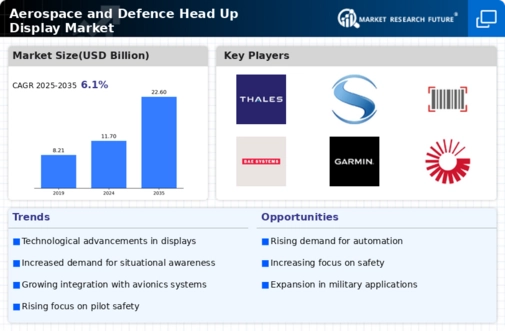Market Growth Projections
The Global Aerospace and Defence Head Up Display Market Industry is projected to experience substantial growth, with estimates indicating a rise from 11.7 USD Billion in 2024 to 22.6 USD Billion by 2035. This growth trajectory reflects a compound annual growth rate of 6.14% from 2025 to 2035. The increasing adoption of HUD systems across military and commercial sectors, coupled with advancements in technology and regulatory support, is likely to drive this expansion. Charts illustrating this growth can provide visual insights into market trends and forecasts.
Technological Advancements
The Global Aerospace and Defence Head Up Display Market Industry is experiencing rapid technological advancements, particularly in augmented reality and display technologies. Innovations such as enhanced night vision and improved data integration capabilities are driving demand. For instance, the integration of artificial intelligence in HUD systems allows for real-time data processing, enhancing situational awareness for pilots. As a result, the market is projected to reach 11.7 USD Billion in 2024, indicating a strong growth trajectory fueled by these advancements.
Military Modernization Programs
Ongoing military modernization programs across various nations are significantly influencing the Global Aerospace and Defence Head Up Display Market Industry. Countries are investing heavily in upgrading their defense capabilities, which includes the incorporation of advanced HUD systems in fighter jets and helicopters. For example, the United States and NATO allies are prioritizing the integration of next-generation HUDs in their fleets. This trend is expected to contribute to a compound annual growth rate of 6.14% from 2025 to 2035, as nations seek to enhance operational efficiency and combat readiness.
Regulatory Support and Standards
Regulatory support and the establishment of standards for aviation safety are pivotal in shaping the Global Aerospace and Defence Head Up Display Market Industry. Government agencies, such as the Federal Aviation Administration and the European Union Aviation Safety Agency, are implementing regulations that encourage the adoption of advanced HUD technologies. These regulations not only enhance safety but also promote innovation within the industry. As a result, manufacturers are increasingly investing in HUD development, which is expected to drive market growth and adoption rates in the coming years.
Growing Commercial Aviation Sector
The expansion of the commercial aviation sector is a significant factor influencing the Global Aerospace and Defence Head Up Display Market Industry. With an increasing number of air travelers and the expansion of airline fleets, there is a heightened demand for advanced cockpit technologies, including HUD systems. Airlines are recognizing the benefits of HUDs in improving pilot performance and passenger safety. This growing demand is anticipated to contribute to the overall market growth, aligning with the projected increase to 22.6 USD Billion by 2035.
Increased Demand for Situational Awareness
The need for enhanced situational awareness in military and civilian aviation is a critical driver for the Global Aerospace and Defence Head Up Display Market Industry. HUD systems provide pilots with essential flight data while maintaining their focus on the external environment, thereby reducing workload and improving safety. As air traffic increases globally, the demand for such systems is likely to rise. This trend is underscored by the projected market growth to 22.6 USD Billion by 2035, reflecting the growing emphasis on safety and operational efficiency in aviation.






















Leave a Comment